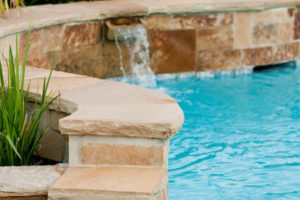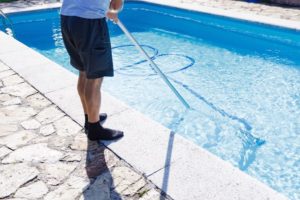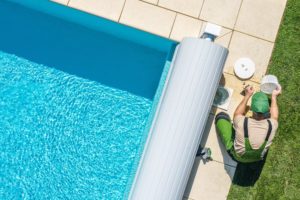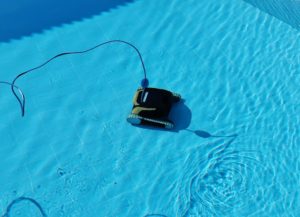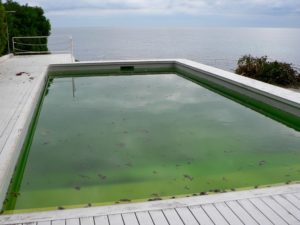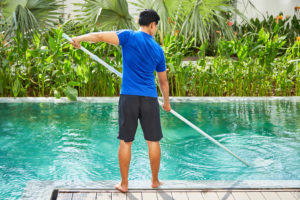Regular pool maintenance is key to keeping your swimming pool clean and safe. One of the most important tasks in pool care is shocking your pool. This process helps clear cloudy water, eliminate bacteria, and restore water balance. In this guide, we’ll walk you through how to shock a swimming pool, why it’s essential, and the best practices to follow for the cleanest, safest pool possible.
What Does It Mean to “Shock” a Pool?
Shocking a pool means adding a high concentration of chlorine or other pool sanitizers to the water. This boosts the chlorine levels to eliminate harmful bacteria, algae, organic matter (like leaves and debris), and chloramines (the compounds that cause that “pool smell”). Regular shocking keeps your pool water clear and safe for swimming.
Why Is Pool Shocking Important?
There are several reasons to shock your pool regularly, including:
- Prevents Algae Growth: If your pool water turns green or cloudy, it’s likely due to algae. Shocking your pool helps eliminate it and prevent further outbreaks.
- Clears Cloudy Water: Shocking helps clear cloudy water caused by debris, bacteria, or chemical imbalances.
- Removes Contaminants: After heavy pool use (like pool parties) or after a rainstorm, shocking helps remove sweat, oils, dirt, and debris that can affect water quality.
- Destroys Chloramines: Chloramines are created when chlorine binds with contaminants in the water. They can cause eye irritation, skin issues, and an unpleasant smell.
- Restores Water Balance: Shocking your pool helps restore balance to the water’s chemistry, ensuring safe swimming conditions.
When Should You Shock Your Pool?
You should shock your pool under the following circumstances:
- Cloudy or Green Water: If your water looks cloudy or has turned green, shocking will help clear it up.
- After Heavy Pool Use: Large numbers of swimmers can introduce oils, dirt, and sweat into the water, requiring a shock treatment.
- After a Rainstorm: Storms can bring debris and contaminants into your pool, necessitating a shock.
- Low Chlorine Levels: If your pool’s chlorine level falls below 1 ppm (parts per million), it’s time to shock your pool to restore sanitizer levels.
How to Shock a Swimming Pool: A Step-by-Step Guide
Shocking your pool is more than just adding chlorine to the pool. It is essential to follow the right steps to achieve optimal results.
Step 1: Test the Pool Water
Before shocking your pool, test the water with a pool test kit or test strips. This helps you understand your pool’s current chlorine levels, pH, alkalinity, and stabilizer (cyanuric acid) levels. Here are the ideal ranges:
- Chlorine: 1-3 ppm
- pH: 7.4-7.6
- Alkalinity: 80-120 ppm
- Cyanuric Acid (Stabilizer): 30-50 ppm
If your chlorine levels are already too high, it may be best to wait a day or two before shocking.
Step 2: Choose the Right Pool Shock
There are different types of pool shock treatments. Choose the right one based on your pool’s needs:
- Calcium Hypochlorite (Cal-Hypo): The most common and affordable shock type. It’s great for clearing cloudy water but may temporarily cloud the pool.
- Sodium Dichlor: Ideal for pools with a cyanuric acid stabilizer and works well for maintaining chlorine levels.
- Non-Chlorine Shock: This is a great option for those who don’t want to add more chlorine to the pool. It’s also effective for pools with already high chlorine levels.
Be sure to follow the instructions on the packaging for proper dosages based on your pool’s size and condition.
Step 3: Prepare the Shock Treatment
Before you add the shock to the pool, it is essential to perform these next two steps:
- Clean the filter
- Adjust the pH
If you’re using granular shock, dilute it in a bucket of water. Never add granular shock directly to the pool without dissolving it first, as it can damage pool surfaces. For liquid shock, simply pour it into the pool according to the instructions.
Safety Tip: Always wear gloves, goggles, and a mask when handling pool shock to protect your skin and eyes from irritation.
Step 4: Add the Shock to the Pool
Shocking should be done in the evening or at night to prevent the sun from breaking down the chlorine too quickly. For even distribution:
- Granular shock: Pour it evenly around the pool perimeter or in front of the return jets.
- Liquid shock: Slowly pour it along the edges of the pool, walking around the entire perimeter.
Step 5: Run the Pool Pump for 24 hours.
After adding the shock, turn on the pool pump to circulate the chemicals throughout the water. This ensures the shock is evenly distributed and works effectively.
Step 6: Wait Before Swimming
Let the shock treatment work for 8-12 hours before swimming. Use a pool test kit to check chlorine levels before re-entering the water. Ensure chlorine levels are between 1-3 ppm for safe swimming.
Step 7: Retest and Adjust Pool Chemistry
Once the shock has had time to work, retest your pool’s water to check the pH, alkalinity, and chlorine levels. Adjust the pH or alkalinity if necessary using pH increasers or decreasers.
Tips for Effective Pool Shocking
- Shocking Regularly: Shocking once a week helps keep your pool water clean and balanced.
- Use Algaecide: If algae is a persistent problem, add algaecide alongside the shock treatment.
- Brush and Vacuum: After shocking, brush pool surfaces and vacuum to remove any dead algae or debris.
- Use Clarifiers: If your pool is still cloudy after shocking, consider using a pool clarifier to help clear it up.
Common Pool Shocking Mistakes to Avoid
- Shocking in Direct Sunlight: UV rays can break down chlorine before it has a chance to work. Always shock at night.
- Over-Shocking: Too much shock can lead to high chlorine levels, causing irritation. Always follow dosage instructions based on your pool’s size.
- Not Running the Pump: The pump helps circulate the shock treatment throughout the pool. Without it, the shock may not be effective.
Conclusion: Keep Your Pool Sparkling and Safe
Shocking your swimming pool is a vital part of pool maintenance that ensures clear, clean, and safe water. By following these simple steps and shocking regularly, you’ll keep your pool sparkling all season long. Remember, shocking should be done after heavy pool use, during chemical imbalances, or when algae or cloudiness appear. With the right shock treatment and a little care, you can maintain a healthy swimming environment for you and your family.
For more pool maintenance tips, be sure to check out our articles on balancing pool water chemistry and how to clean your pool filter.
Frequently Asked Questions About Pool Shocking
How often should I shock my pool?
It’s generally recommended to shock your pool once a week or after heavy pool use or storms. If you’re dealing with algae or cloudy water, you may need to shock more often.
Can I swim immediately after shocking the pool?
No, wait at least 8-12 hours or until the chlorine levels drop back to 1-3 ppm to ensure it’s safe to swim.
What happens if I use too much pool shock?
Excessive shock can cause high chlorine levels, leading to skin irritation or damage to pool surfaces. Always follow dosage instructions carefully.

